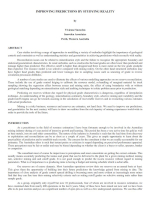Добрый день, Коллеги. Важное сообщение, просьба принять участие. Музей Ферсмана ищет помощь для реставрационных работ в помещении. Подробности по ссылке
Improving predictions by studying reality / Улучшение прогноза на основе изучения реальности
Case studies involving a range of approaches to modelling a variety of orebodies highlight the importance of geological controls and constraints as well as understanding statistics and geostatistics in achieving predictions which reconcile with reality.
Reconciliation issues can be related to mineralisation style and the failure to recognise the appropriate boundary and statistical/geostatistical characteristics. In zonal orebodies such as stockworks the head grades are often lower than predicted and tonnage higher than predicted. The effective cutoff is higher than designed and there is more metal on the low grade stockpile than expected. The resource model is too selective compared with mining reality. On the other hand structured orebodies may have higher head grades than predicted and lower tonnages due to sampling issues such as smearing of grade in reverse circulation percussion drillholes.
A number of case studies are used to illustrate the effects of various modelling approaches on ore reserve reconciliation. These include the use of grade control kriging to calibrate the resource model, re-handling of marginal material by truck sampling showing the regression effect between assays and mining units, the effect of using boundaries with or without geological matching depending on mineralisation style and auditing techniques to isolate problem areas prior to production. Predicting ore reserves without due regard for physical grade characteristics is dangerous, regardless of interpolation technique. An understanding of the geology, mineralisation continuity, boundary style, selective mining unit variability and the grade/cutoff enigma can go far towards assisting in the calculation of recoverable reserves and in reconciling various estimates with actual production.
Mining is a risky business; resources and reserves are estimates, not hard facts. We need to improve our predictions, and geostatistics for the next century will have to draw on realities from the rich tapestry of mining experiences world-wide in order to provide the tools of the future <...>




